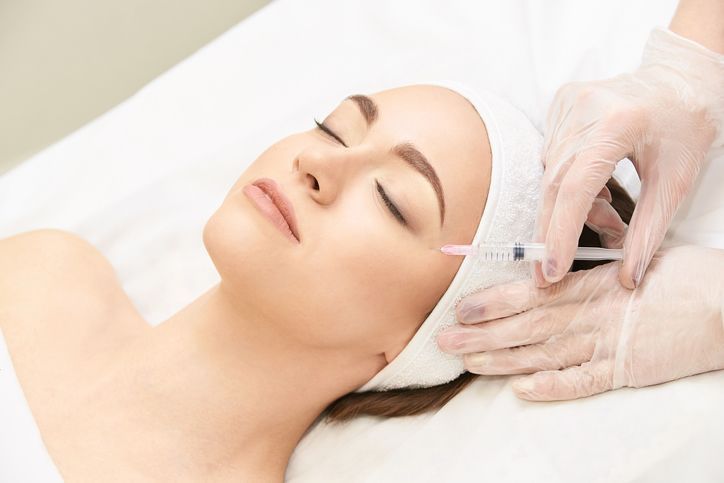
What is Botulinum Toxin?
Botulinum is a toxin derived from a bacterium called clostridium botulinum. This toxin, called botulinum toxin type A, is the toxin that causes toxication in rotten canned food. The toxins of these bacteria, which are produced in a special laboratory environment, are obtained by providing sterility and cold chain conditions. It is essentially a protein. It is stored under cold chain conditions as it may lose its effect quickly with the effect of heat and may become ineffective with denaturation. However, it is never a venom.
Botulinum toxin creates a temporary paralysis in the muscles by suppressing the conduction at the neuromuscular junction. In this way, mimics are restricted and wrinkles are opened. It imitates the mediator called acetylcholine at the neuromuscular junction and replaces it, and as long as it stays at the nerve-muscle junction, it prevents the acetylcholine mediator from having an effect. In this case, muscle contraction is prevented. The patient cannot make mimics that he has been accustomed to for many years. In this way, wrinkles are opened. At first, this state of mimics is a situation that patients are not used to, so it may take time to get used to it. When the effect of Botulinum toxin begins to reduce, mimics gradually return and wrinkles begin to reappear. The pleasing matter is that although all effects and side effects of botulinum toxin are temporary, they never cause permanent damage to the body.
- Wrinkles
- Frowning lines
- Crow’s feet lines (around the eyes)
- Lines on the nose (rabbit lines)
- To lift the nose tip in the patients who pull the nose tip down while talking
- Beauty lines on the lips (cigarette or barcode lines)
- Neck lines (nefertiti)
- Migraine type headaches
- Tension-type headache on the neck
- Bruxism (masseter)
- Botulinum toxin in the wrinkles on the chin that are evident with facial expressions
- Keloid treatment
- Palms and soles sweating
- Armpit sweating
- Sweating on face, forehead, hairy skin
- Inguinal and anus sweating
How is Botulinum Toxin Applied?
Botulinum toxin is applied by using very fine-point needles. The pain is extremely low. However, pain can be reduced with the help of local anesthetic cream in the patients with low pain threshold. The process is completed in a short period of time like 5-10 minutes. Short-term side effects such as bruising and redness can be easily covered with concealer, and then you can easily return to daily life.
How Long Does the Effect of Botulinum Toxin Last?
Its effect starts after 2-3 days at the earliest, its effect peaks in 10 days and lasts for an average of 4-6 months. Then the effect wears off, and muscle movements return. Wrinkles take their previous form. Thanks to Botulinum toxin, the wrinkles that cannot be used frequently are forgotten over time and as they are not used, the wrinkles return even less than before. Repetitive applications prolong the term for permanence.
The use of green tea, herbal teas, alcohol, pain relievers after the procedure shortens the effect of botulinum toxin. However, it should not be worried that consuming such products may not cause toxic side effects that may cause any concern in the patients. The only problem is that they are known to shorten the duration of botulinum toxin effect, so it is useful to be informed about the long-term botulinum toxin effect. After the procedure, the use of Turkish bath, sauna, heavy exercises, and hot applications are not recommended by the doctors as they accelerate the spread of botulinum toxin and shorten the duration of its effect.
Is Botulinum Toxin Harmful?
Botulinum toxin does not spread to the whole body, it stays where it is injected, thus, it has no systemic side effects. After the application, temporary swelling and bruising may occur due to the needle, but it is very rare. After botulinum toxin application, it is recommended to apply pressure to the area where botulinum toxin is applied, to make scrubbing, massage, and to rest the forehead on a hard surface. Again, it is recommended to keep the head up for 4 hours. Otherwise, botulinum toxin may not stay in the applied area, but may also spread to other areas and cause unwanted side effects.
At the beginning of these side effects, drooping eyelids, double vision, shifting in the corners of the mouth, and speech-laugh asymmetries may develop. The essential problem is the problems caued by misapplication conducted by incompetent people. Botulinum toxin must be applied by a specialist.
Who Shouldn't Have Botulinum Toxin?
It is not yet known whether botulinum toxin has a harmful effect during pregnancy and lactation. Thus, it is recommended not to apply botulinum toxin during pregnancy and lactation period. It should not be applied to people with diseases of the nervous system and musculoskeletal system. Since it is known that there are some drug interactions, it is important that you inform your doctor correctly about all the treatments you use.
